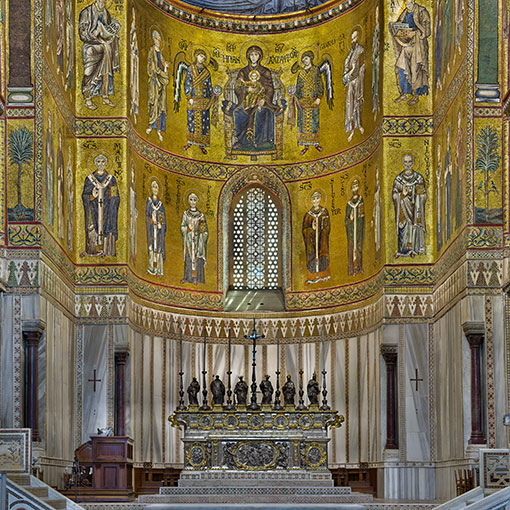Monreale, Duomo, abside: i mosaici. Il Duomo di Monreale, o Cattedrale di Santa Maria Nuova, fu costruito a partire dal 1174 per volere di Guglielmo II d’Altavilla, re di Sicilia dal 1166 al 1189, ed è famoso per gli splendidi mosaici che ne abbelliscono l’interno. La decorazione musiva, realizzata probabilmente tra il 1180 e il 1190, si estende per 6.340 metri quadrati ed è la più vasta d’Italia. Illustra scene tratte dall’Antico e dal Nuovo Testamento e culmina nell’abside centrale con la suggestiva visione del Cristo Pantocratore. In questo gigapixel si può vedere tutta l’abside con, in alto, il mosaico del Cristo Pantocratore, la Vergine in trono circondata da due arcangeli e una teoria di santi. In basso, si trova l’altare d’argento eseguito nel 1771 dall’argentiere romano Luigi Valadier su commissione dell’arcivescovo Francesco Testa. Sopra l’altare, le sei statue in argento dorato rappresentano Santa Rosalia, San Benedetto, San Paolo, San Pietro, San Castrense, San Luigi (Re Luigi IX di Francia).
Monreale, Duomo, apse: the mosaics. The Cathedral of Monreale, or Cathedral of Santa Maria Nuova, was built from 1174 at the behest of William II of Altavilla, king of Sicily from 1166 till 1189, and it is famous for the splendid mosaics that adorn the interior. The mosaic decoration, probably realised between 1180 and 1190, covers 6,340 square meters and it is the largest one in Italy. It depicts scenes from the Old and New Testament and culminates in the central apse with the evocative vision of Christ Pantocrator. In this gigapixel you can see the entire apse with, in the upper part, the mosaic of Christ Pantocrator, the Virgin enthroned surrounded by two archangels and a theory of saints. In the lower part, you can see the silver altar made by the Roman silversmith Luigi Valadier in 1771 and commissioned by Archbishop Francesco Testa. The six gilded silver statues above the altare represent St. Rosalia, St. Benedict, St. Peter, St. Castrense, St. Louis (King Louis IX of France).
